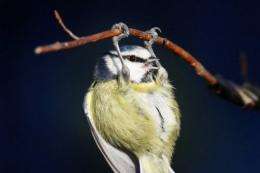British small bird numbers bouncing back: survey

Small garden birds which were hit by the long, harsh winter a year ago have bounced back in Britain this year, according to results from the RSPB's Big Garden Birdwatch survey.
Sightings of goldcrests, the UK’s smallest birds, doubled, long tailed tits increased by a third and coal tits increased by a quarter.
The RSPB says small birds can be particularly badly hit by harsh winters but a good breeding season can help turn around their fortunes, and the survey results suggest this may have been the case in 2010.
Over 600,000 people took part in this year’s birdwatch, a record breaking number watching their garden birds, the society says. Over 70 species were recorded in 300,780 gardens across the UK over the weekend on January 29 and 30.
Among the survey's other findings, more than 7,000 waxwings were recorded in almost 1,000 gardens as the birds came to the UK from Scandinavia in an influx known as a "waxwing winter" which occurs every few years.
House sparrows top the list of commonly seen birds for the eighth year running, but while their numbers were up 10% on last year, they were far lower than they were when the first birdwatch took place in 1979.
The same is true for other birds in this year's top 10 most common species in gardens. Starling numbers increased by a quarter this year to put them into the second spot but overall their numbers have fallen by three quarters since 1979.
Other garden favourites have seen numbers drop in the past three decades, with robin sightings falling by a quarter and blackbirds and chaffinches down by around a fifth since 1979.
Meanwhile, blue tits, great tits, wood pigeons and collared doves are all being spotted in greater numbers than they were in 1979, and the goldfinch, which was not seen in gardens when the survey started, is now the eighth most common visitor seen by householders.
Big Garden Birdwatch co-ordinator Sarah Kelly said: "We were really interested to see how the small birds fared, after such a disastrous last year.
"It appears that many may have had a decent breeding season and have been able to bounce back a little. But we mustn't be complacent. Another hard winter could see numbers back down, so it's important everyone continues to feed their garden birds."
Surveys of birds found in school grounds by teachers and pupils revealed that blackbirds were the most commonly seen species, spotted in 87% of playgrounds. Starlings, wood pigeons and black-headed gulls were also commonly seen.
(c) 2011 AFP














